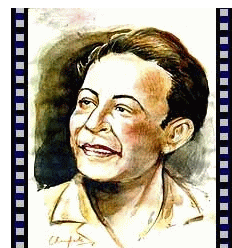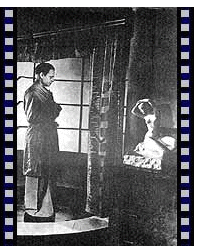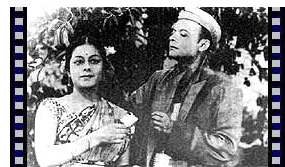The early part of the last
millennium proved to be a cultural curtain raiser for Indian film
industry. More so is the case with Assam. Three years in particular are
significant, viz., 1903, 1935 and 1951.
 Similarly, two historical
places also hogged the limelight as two illustrious sons of Assam were
born in the same year, 1903, at Tezpur and Gauripur.
Similarly, two historical
places also hogged the limelight as two illustrious sons of Assam were
born in the same year, 1903, at Tezpur and Gauripur.
The father of
Assamese films, Rupkonwar Jyotiprasad Agarwalla was born at Tamulbari tea
estate in the eastern place of Tezpur while the pioneer of artificial
lighting, realistic films with natural histrionics and diehard supporter
of workers’ rights in the film studios in India, Pramathesh Chandra Barua
was born at the western province of Gauripur.
Both these
visionaries had many things in common. They were nationalists as well as
ardent students of creative art. These famous film makers had their
initiation into modern techniques of the trade in Europe.
What is
more, the first film in Assamese, Joymoti by Agarwalla and
Devdas — the first film in India to inculcate modern means like
flashback montage and telepathy shots besides natural acting by artistes
to portray common human dilemma via what is now termed subjective camera —
by Barua were released in 1935.
While Jyotiprasad had set up a
temporary studio, ‘Chitraban’ at Bholaguri tea garden, Pramathesh too
constructed ‘Barua Studio’ beside his house in Calcutta.
Another
important trait that was dear to both was their zeal to serve the
downtrodden. This humanist strain more often than not compelled them to
tread slippery steps away from their traditional and sophisticated
families’ beaten track.
However, various factors forced Barua to
shift his working place to Calcutta while Agarwalla chose to remain in
Assam. This single aspect has also led cynics to pose, “What has Barua
done for Assam?” Many have even dared to raise unwarranted questions about
his roots and tilt towards Bengal.
Such debates, if they can at
all be termed so, must be set at rest once and for all. The very fact that
Barua was born to a ruling family in Goalpara district, reared in Assam’s
natural bounty and also worked in her power corridors should suffice to
silence doubting Thomases.
Noted folklorist and artiste Birendranath Datta
summed up: “Pramathesh Barua was born into a situation where Bengali
was the medium and lingua franca of the middle and upper classes as well
as the zamindar families in Bengal and Goalpara. Moreover, the white
collar workers in his father’s office were also from
Bengal.
“This notwithstanding, doubting Pramathesh’s roots would
be same as casting aspersions on the identity of the people of greater
Goalpara. Since the days of Naranarayan, the Koch Kingdom included western
Goalpara and a large section of North Bengal. Though Assamese is now the
medium of instruction in Goalpara, the dialect there has much affinity
with the one spoken in the nearby places in Bengal. It was, during the
Koch king’s time, a cultural unit. So is it today to a certain extent. But
that does not necessarily mean, the people in Goalpara are not of
Assam.”
Barua adopted cinema since its silent days as a means to
not just reflect the moods, clash of egos and mental strife of his
protagonists but also as a tool to educate the masses. He always
endeavoured to experiment with themes and techniques. His diaries show how
he was aghast at the plight of the poor. He tried to highlight their woes
in his work.
Barua said that he was disgusted with power struggle
and hence embraced the world of creativity. By changing his course, he
could deliver invaluable contribution to Indian creative form, to be
precise cinema.
Pramathesh was very much influenced by the
cultural environment of his home. In fact, his father and other members of
his immediate family have contributed a lot of the broadcast as well as
preservation of Goalpara culture outside Assam.
Needless to say,
annals prove that this region has been the domain of kings from various
dynasties like Kirats, Burmans, Shilasthambas, Palas, Kamatas, Kochs,
Ahoms besides being under Pathan rule from 1498-1505. The Koch rulers had
their domain here till 1581 while the Ahom rule extended in this province
from 1659-1661. Earlier, the Kamata Kings ruled from 1305-1498. From 1765
it came under the British Raj.
The history of Gauripur’s Jamindar
family has been vividly traced in renowned historian and sociologist
Nagendranath Basu’s three volume book The Social History of Kamrup.
As per its accounts, the father of Pramathesh Chandra Barua, Raja Prabhat
Chandra Barua was the adopted son of Pratap Chandra Barua who is the
lineage of Govinda Giri Bhuyan of the Kashyap Gotra. It was in 1856 that Pratap Chandra Barua’s family settled in Gauripur from
Rangamati.
Pramathesh’s mother, Sarojbala, was from Sankardeva’s
Vaishnava Sattra culture. The influence of Sankari tenets on Pramathesh
was overwhelming. He was a vegetarian and his heart flowed with humanity,
tolerance and love for fellow beings including all forms of animals. He
was an avid lover of horses and horse races. Litterateur Phani Talukdar in
his book on this glowing personality mentions that Barua used to make time
amidst his tight schedule for tending his horses in Calcutta. He was a
champion of animal rights. Though, the zamindari past time also included
hunting, Barua tried to distance himself from this ‘sport’ in the initial
stages and subsequently totally avoided it.
Pramathesh was born on October 3, at the strike of midnight hour
in 1903. A mendicant had earlier in January that very year told his
parents in Delhi when they went to seek his blessings for a child that
they would be begetting a son who would carry the name of the family to
new heights. This trip was to participate in Lord Curzon’s Delhi durbar on
the formers’ invitation. Pramathesh’s other siblings are Niharbala,
Nilima, Prakritish and Pranabesh. He was lovingly called ‘Moni’ by his
parents. He had a separate study room in Matiabagh palace. All steps were
taken to groom him — culturally as well as academically.
 During
his youth, he had set up a socio-cultural theatre group in Gauripur. This
GYMA Club was later christened the United Club. He used to take initiative
in staging various plays like Khasdakhal (where he looked after its
direction, lighting, music and also acted), Chandragupta, Surashi,
Europer Rani, Samaj Durgadas, Biraz Bose, Phulsor Nurjahan, Prafulla,
Banganari, Bibah Bibhrat, Kinnari, Phelaramer Swadeshekota and
Shinghal Bijoy among others. Besides enacting the lead role, he
also acted in the women’s characters.
During
his youth, he had set up a socio-cultural theatre group in Gauripur. This
GYMA Club was later christened the United Club. He used to take initiative
in staging various plays like Khasdakhal (where he looked after its
direction, lighting, music and also acted), Chandragupta, Surashi,
Europer Rani, Samaj Durgadas, Biraz Bose, Phulsor Nurjahan, Prafulla,
Banganari, Bibah Bibhrat, Kinnari, Phelaramer Swadeshekota and
Shinghal Bijoy among others. Besides enacting the lead role, he
also acted in the women’s characters.
In fact prior to his
full-fledged attachment to the movie world and clearing his degrees with
honours in Physics from Presidency College in Calcutta, Pramathesh built
up an environ for amateur theatre in Gauripur, obviously with influence
from the vibrant theatre movement in then Calcutta.
He had a
pachyderm called Jungbahadur who used to be his companion in his hunting
safaris. Phani Talukdar refers to Barua’s family sources while mentioning
that Pramathesh had first hunted a Royal Bengal Tiger on March 8, 1915
when he was twelve years of age. And, on June 2 he had shot a Cheetah.
Altogether Pramathesh hunted in the family safaris 52 Royal Bengal Tigers
besides many Cheetahs, bears, deers, wild buffaloes, rhinos and birds.
When Jungbahadur died, the mortal remains were buried in Gauripur, and his
tusks as well as head bone were preserved in the Matiabagh residence.
Pramathesh was a snap shooter. However, there is an interesting anecdote
which says that on a rare occasion Pramathesh missed his target.
Jungbahadur too got so surprised that he moved his trunk backward to feel
whether the shot really was based by Pramathesh.
After completion
of his early schooling at home, Pramathesh was sent to Hare school where
he enrolled himself in the IXth standard. He was attracted to the world of
acting during this period.
In 1921, at the wish of his mother,
Pramathesh married the eldest daughter of Birendranath Mitra (resident of
Bagbazar, Calcutta), Madhurilata. Madhurilata provided the rudder
to his ship which had to weather many storms — professionally, personally
as well as socially. She always proved to be the beckoning light for his
struggling spirit and ever restless vigour.
Noted writer and a
friend of Pramathesh’s brother Prakritish, Sheelabhadra said, “Madhurilata
was so broad-minded and kind to all that she was the cynosure of all
eyes.”
The founder principal of Pramathesh Chandra Barua College
in Gauripur and folklorist Birendranath Datta corroboroted, “She imbibed the
Goalparia culture. Actually, Madhurilata baideo could speak chaste
Goalparia better than any local resident.”
Though Pramathesh
married twice more — Amala Bala Barua and co-artiste in Devdas
Jamuna Barua — he always respected, adored and loved Madhurilata. His will
bequeaths to all his wives and six sons adequate lifelong financial
security.
Pramathesh tried to concentrate on zamindari affairs
after his return from first trip to Europe and demise of his mother in
1926. He could then attract the attention of the British regime by his
astute statesmanship and typical stand in favour of his ryots’ rights
during a meeting with Simon Commission in Calcutta. He was then elected
unanimously to Assam Bidhan Parishad.
After the demise of his
father, Pramathesh handed over the charge of zamindari to his brother
Prakritish and dedicated himself to the world of creativity.
It
was in 1930 during his trip to London and Europe that he used the
opportunity to learn modern techniques of movie lighting from Mr Rozars,
cameraman with Paris-based Fox Studio, as a light boy. He had been to
London with his younger brother in-law (husband of Nilima Barua) Santosh
Kumar Barua, maternal cousin Sailesh Chandra Barua and family physician
Lalmohan Ghosh for removal of stones from his urinary track. The surgeon
was Dr Troater who had done a similar operation on King George-V.
 Pramathesh was lucky to get a reference letter from Kabiguru
Rabindranath Tagore to Fox Studios recommending Barua for the training.
This stint came in handy as Barua became the pioneer in using artificial
lighting in Indian films.
Pramathesh was lucky to get a reference letter from Kabiguru
Rabindranath Tagore to Fox Studios recommending Barua for the training.
This stint came in handy as Barua became the pioneer in using artificial
lighting in Indian films.
Till then, sun’s rays were used with
the help of reflector for lighting purposes in film making. Pramathesh for
the first time in the country used a 40,000 watt lighting and also
designed the sets and costumes required for such
improvisation.
This technique he used for his silent film
Aparadhi. The storyline was his and it was completed on November
28, 1930, at his Barua Film Unit in No 14 Baligunj Circular Road. The
cameraman was Krishna Gopal (KG) and the stars included besides
Pramathesh, Prabhabati Barua, Nirmal Banerjee, Samar Ghosh, Radhika
Mukherjee, among others. Aparadhi was Pramathesh’s maiden work as
producer.
He formally entered the film world in 1926. Veteran
film maker and Phalke awardee Dhirendranath Ganguli made him join his
organisation ‘The British Dominian Film Limited’. Both had got acquainted
in Santiniketan.
Pramathesh was also granted fellowship from
Calcutta University. In 1949, he was feted at a meet at India House in
London by then Indian High Commissioner, VK Krishna Menon. Subsequently he
was nominated as the organisational convenor of the newly-constituted
Indian Film Society. The Trust Board formed to decide upon the objectives
of this organisation had as its chairman Pandit Jawaharlal Nehru and VK
Krishna Menon as its patron.
Pramathesh was also a member of the
organisation of British film experts — The British Cinematograph Society.
Mentionably, he was the first Indian and non-European to be a part of this
august body.
Pramathesh delivered speeches twice through the
British Broadcasting Corporation (BBC). Moreover, he actively participated
in various cultural programmes including directing chorus at the famed
Kingsway Hall in London. He even acted in Tagore’s dance drama
Barshamangal.
In 1930, after being elected to the Assam
Bidhan Parishad, he was even offered a cabinet post by then British
Governor. But the nationalist in him spurned the offer. Instead he took up
the post of chief whip of the State’s Swarajya Party, influenced as he was
since his students days by Chittaranjan Das and other freedom
fighters.
Pramathesh in those early days of film making knew the
value of marketing films in other regions besides abroad. This is evident
from his diaries. He always strived for excellence and in the process was
the bridge between the present and the future. He never disregarded his
past or heritage.
Though circumstances bogged him down, his
association with New Theatres in 1933 at the instance of Birendranath
Sarkar proved to be a watershed for Indian films in general. He
successfully produced several films including his masterpiece
Devdas based on litterateur Sarat Chandra Chattopadhyays
protagonist. Later on, he also worked with Krishna Movietone in 1940 and
MP Productions as well as Associated Pictures, among others.
He
tried to produce educational documentaries with Rank Organisation, an
European unit. However, he could not complete the series owing to failing
constitution.
He breathed his last on November 29, 1951 at his
home in 12/3 Maulin Street. His last rites were performed at Keoratala
cremation ground in Calcutta. Twenty days later, his ashes were immersed
in the Godadhar and at Neematighat in the Brahmaputra in the presence of a
large number of fans.
In 1963, a two-day commemoration meet was
held in Guwahati when an exhibition of Pramathesh’s work was organised.
Two of his film — Devdas and Uttarayan were also screened in
the District Library auditorium. A souvenir edited by Jogesh Das was also
brought out. Noted personalities including Chandraboti Devi from Calcutta
came here and dwelt on Pramathesh work. Artiste Benu Misra did a large oil
painting of Barua. This painting now adorns the principal’s chamber of
Pramathesh Barua College in Gauripur, informed Datta.
Steps are
on to organise a yearly memorial lecture in his name. On his death
anniversary this year, the first memorial lecture would be held, Among the
speakers shortlisted are Mrinal Sen, Soumitra Chatterjee, Chidananda Das
Gupta and Apurba Sarma.
There is also a move to organise local
functions to highlight Barua’s contribution through the local centres of
the Directorate of Culture in Assam. The committee organising the birth
centenary of this illustrious personality has also decided to move the
State Government for dedicating the local unit of Cultural Directorate in
Gauripur in the memory of Pramathesh.
BARUA'S
FILMS
Silent Films
l
Kamanar Aagun, Takai Ki Na Hoi, N’ti boy, Aalik
Babu, Panchashar, Maraner Pare, The Border Thik and
Charitrahin — produced when he was with the British Dominion
Films Limited.
l
He acted as a villain in
Bhagyalakshmi under the banner of Indian Cinema Arts. It was
directed by Kaliprasad Ghosh.
l
Aparadhi
with his storyline from his Barua film unit with direction by Debaki Basu.
Released on November 28, 1931.
l
Akada from
the same house. It was directed by Sushil Mazumdar. Released on April 2,
1932. Both the last three films were released in Chitra Cinema Hall,
Calcutta.
Films With Dialogue
l
Bangla 1983, Ruplekha, Mahabbat Ki Aasu,
Devdas (Bengali – March 30, 1953) and the Hindi version released on
September 21, Abasesha, Grihadah, Manzil, Mayn, Mukti, Aadhikar, Rajat
Jayanti, Zindagi, Shap Mukti, Mayer Pran/Uttarayan, Shesh Uttar and
Jabab.
Incomplete Work
l
Agragami (1947), Mayakanan (1947),
Iraqi Akra (Hindi), Aabhimans, Doctor, Pandit Mashai, the
series of educational documentaries with Rank Organisation of J Arthur
besides Pandit Mashai.
